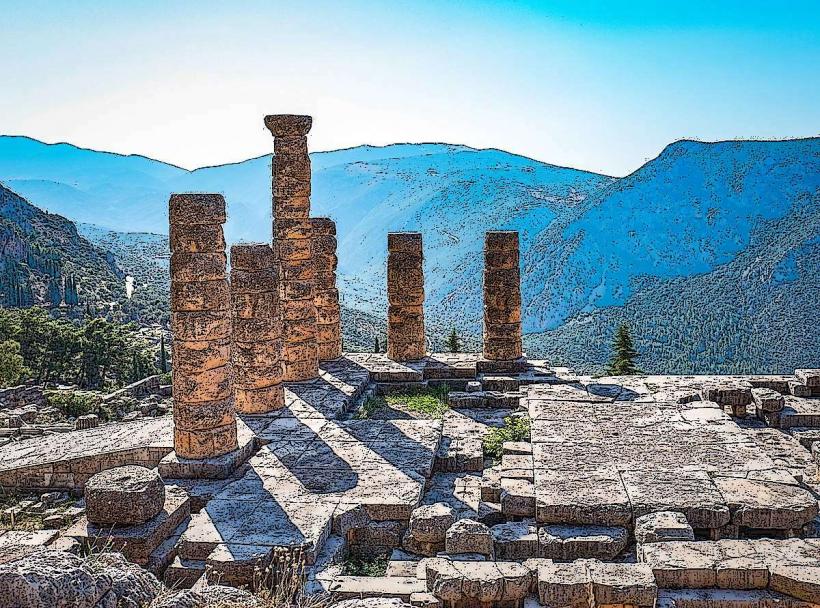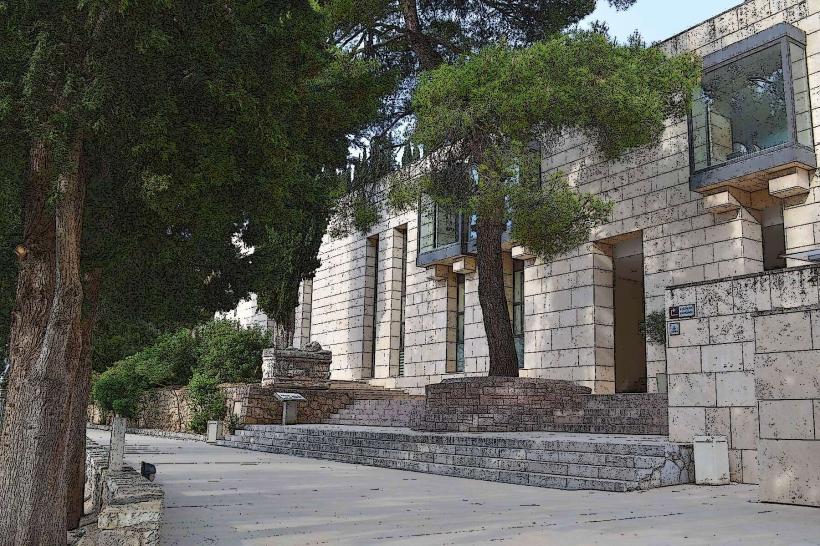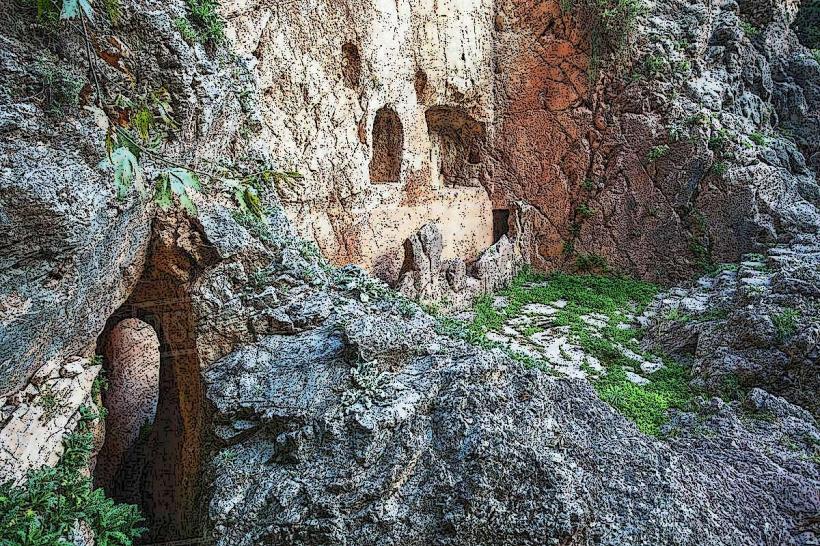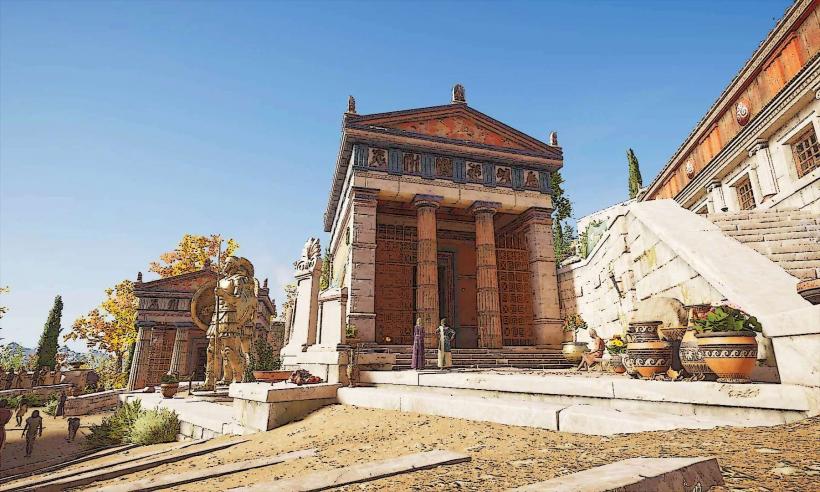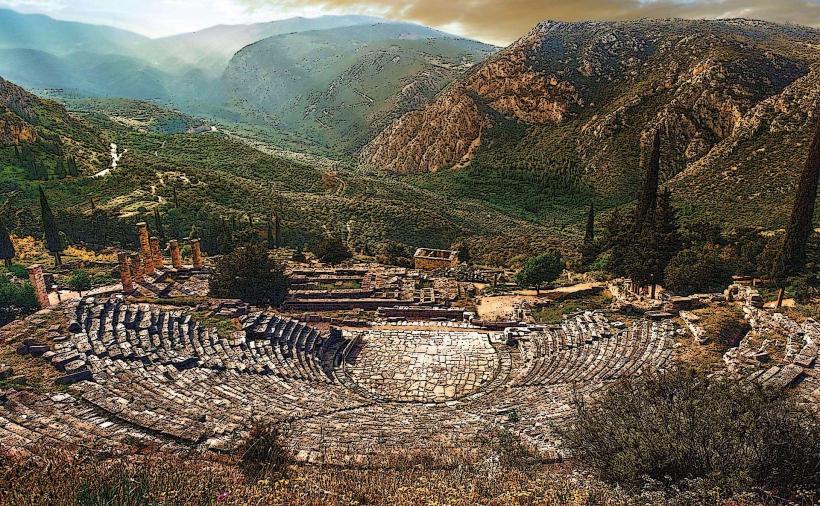Information
Landmark: Tholos of DelphiCity: Delphi
Country: Greece
Continent: Europe
The Tholos of Delphi is one of the most iconic and enigmatic structures in the ancient sanctuary of Apollo at Delphi, Greece. Located on the southern slope of Mount Parnassus, the Tholos is a circular building that is often regarded as one of the finest examples of ancient Greek architecture. Its precise function and purpose remain somewhat uncertain, adding to the mystery and allure of the structure.
1. Historical Context and Purpose
The Tholos was constructed around the 4th century BCE, likely around 360 BCE, during the Classical period of ancient Greece. It is attributed to the architect Theodorus of Phocaea, who is also credited with designing other important structures in the ancient Greek world.
- Dedication: The Tholos is generally believed to have been dedicated to Athena Pronaia, the goddess of wisdom and warfare. This is supported by the presence of inscriptions and references to Athena in the area, as well as the fact that the Tholos is located near the Temple of Apollo.
- Function: The exact function of the Tholos remains debated among scholars. Some suggest it may have served as a sanctuary or temple dedicated to Athena or another deity, while others propose that it could have been a treasury, or even a building for rituals related to the Oracle of Delphi. Some theories also suggest it may have been a monument commemorating Delphi's religious and political importance.
The Tholos is often associated with the broader religious and civic practices in Delphi, where both athletic and religious events took place, and where offerings and dedications were made to various gods, including Apollo.
2. Architectural Features
The Tholos is a circular, peristyle structure built in the Doric style, which was the most common order for Greek temples. However, it is unique because of its circular design, which was uncommon for temples dedicated to gods like Athena.
- Dimensions: The building’s diameter is about 13.5 meters (44 feet). It was relatively small compared to other monumental buildings at Delphi but still stands out due to its unusual design and grandeur.
- Columns: The Tholos originally had 20 Doric columns that formed a circular colonnade around the building. These columns were relatively slender, with a height of approximately 6 meters (20 feet), and they were made from local limestone. The columns were arranged in a way that gave the structure a sense of harmony and symmetry.
- Roof: The roof of the Tholos was conical, made of marble and tile, with a distinctive circular design that contributed to the building’s striking appearance. A circular, or domed, roof was relatively rare in Greek architecture, further adding to the uniqueness of the Tholos.
- Interior: The interior of the Tholos was a circular space with no clear, direct evidence of a statue or cultic object at the center. This has led to speculation that it may have been an open space for ritualistic activities, but the lack of clear artifacts makes the purpose of the interior uncertain.
The structure’s design is a remarkable example of Greek temple architecture that blends the typical Doric features with a more experimental form, reflecting the creativity and innovation of the time.
3. Sculptural Decoration
The Tholos of Delphi was not only architecturally impressive but also adorned with sculptural decoration that would have made it an even more striking and visually captivating structure.
- Frieze: The Tholos had a sculpted frieze that decorated its exterior. It is believed to have depicted mythological scenes, likely involving the gods, but unfortunately, the exact details of the scenes are lost. Inscriptions and traces of the frieze’s existence have been found in excavations, and some scholars believe it showed the Gigantomachy (the battle between the Olympian gods and the Giants), a popular theme in ancient Greek art that symbolized the triumph of order over chaos.
- Sculptures of the Pediment: It is believed that the pediment of the Tholos featured sculptures depicting a mythological scene, though the details of these sculptures are also unclear. Some interpretations suggest that the subject may have been related to the Argonauts or other mythological heroes.
- Metopes and Decorative Elements: Other parts of the building were decorated with relief sculptures, including metopes (the square panels between the columns) and other ornamental features, although much of the decoration has not survived or remains only in fragmentary form.
4. Cultural and Religious Significance
- Religious Role: The Tholos likely had a significant religious role in the sanctuary of Delphi. Delphi itself was one of the most important religious sites in ancient Greece, as it was home to the famous Oracle of Apollo. Pilgrims traveled to Delphi from across Greece and beyond to consult the Oracle, and the Tholos may have been used for additional religious or ritual purposes, possibly linked to divination, purification, or other sacred activities associated with the god Apollo or Athena.
- Symbolism of the Circular Shape: The circular shape of the Tholos is thought to symbolize the eternity and completeness of the divine. In many ancient cultures, circles represented unity, wholeness, and the cosmos. As a sanctuary dedicated to Athena, the Tholos could also represent the harmony and balance associated with this goddess, who was revered for her wisdom, strategic warfare, and craftsmanship.
- Commemoration and Prestige: The Tholos also stood as a symbol of Delphi’s prestige as a religious and cultural center. Its construction demonstrated the wealth, power, and artistic skill of the people who sponsored it. It is likely that the Tholos was a landmark for those visiting the sanctuary, and it was probably an important place for making offerings to the gods.
5. Modern Archaeological Findings
The Tholos is one of the most photographed and visually striking monuments at Delphi today. Though it has not been as well preserved as some other parts of the sanctuary, significant restoration work has been carried out, and the structure still stands partially intact.
- Restoration: In modern times, the Tholos has been partially reconstructed to give visitors a sense of its original grandeur. The 20 columns and parts of the circular wall of the building have been restored, allowing visitors to appreciate its design and its place within the larger context of the Delphi sanctuary.
- Excavations: Excavations around the Tholos have uncovered various fragments of its sculptural decoration, as well as inscriptions that shed light on its possible religious function and significance. Many of the artifacts and fragments that were found in the area have been moved to the Delphi Archaeological Museum for preservation and display.
Visitors to the Delphi Archaeological Site can walk around the Tholos and admire its architectural elegance, surrounded by stunning views of the surrounding mountains and valleys. The structure remains one of the most memorable and visually captivating monuments in the entire sanctuary.
6. Visitor Experience
The Tholos stands on a raised terrace, giving it a commanding view of the surrounding landscape. When visiting the site, tourists can appreciate both the historical importance of the structure and the breathtaking beauty of its location. The site offers a unique opportunity to experience the blend of architecture, mythology, and religious life in ancient Greece.
- Photographic Opportunities: Due to its dramatic setting and the partial restoration of its columns, the Tholos of Delphi is a favorite subject for photography. Its circular design and distinctive roof shape stand out against the backdrop of Mount Parnassus, creating a visually striking scene.
Conclusion
The Tholos of Delphi is one of the most unique and significant monuments in ancient Greek architecture. Its precise purpose remains a subject of scholarly debate, but its grandeur and symbolic significance are undeniable. As part of the Delphi archaeological site, it serves as a reminder of the religious, artistic, and political importance of Delphi in the ancient Greek world. The Tholos continues to captivate visitors with its beauty and mystery, offering a glimpse into the spiritual and cultural life of ancient Greece.

